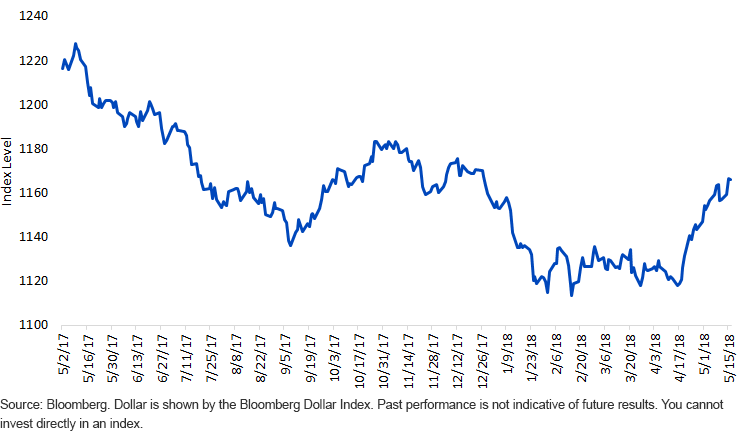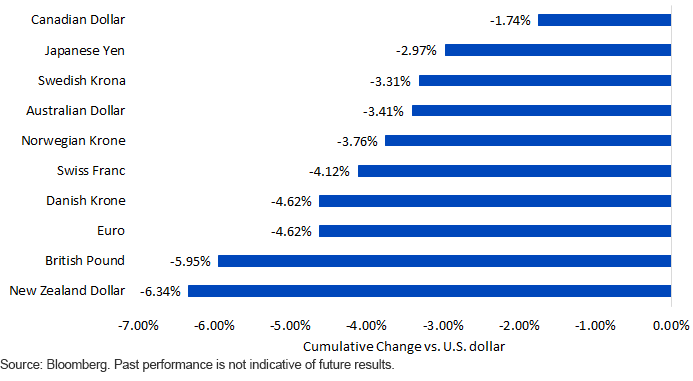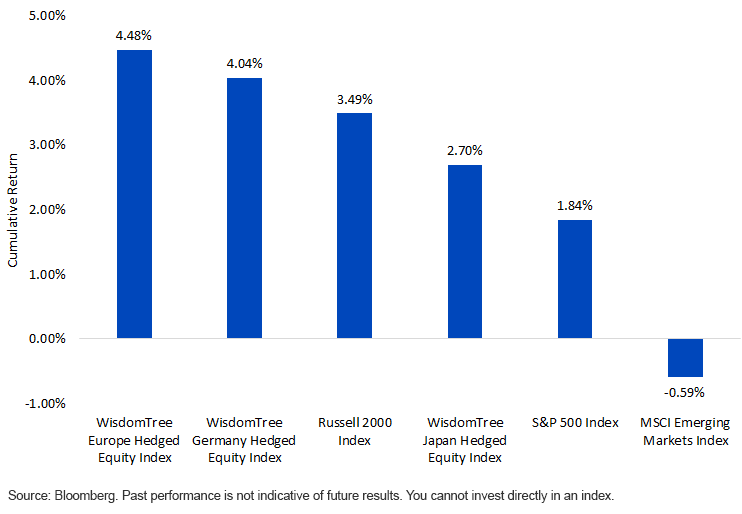Anatomy Of A Dollar Rally
In the era of central bank policy influence, we have become used to large shifts in the performance and trends of different currencies across time. For the better part of the past two years, the currency headlines have been dominated by a weakening U.S. dollar. Connecting the dots, the implications of this have been:
- A very nice tailwind to the earnings of large-cap, multinational U.S. stocks—particularly those with a lot of exports.
- A strong commodity rally—remember when we were speculating if a barrel of oil would go below $20 in February 2016? Those thoughts have since receded.
- Strong performance out of emerging markets, where currency appreciation versus the dollar plus positive equity performance has worked together to create a stronger return backdrop for U.S. dollar investors.
Are We Seeing a Shift toward a Strengthening U.S. Dollar?
Currencies rarely move in a single direction for an extended period— especially in today’s world. Therefore, we believe in being particularly attentive to anything that may signal a change in trend because the ideal playbook for a weak U.S. dollar environment is not the same as the ideal playbook for a strong U.S. dollar environment.
April to May 2018 Showed a Steep Upward Dollar Move (5/2/17–5/16/18)

- As we can see in the chart, over the last year—from May 2, 2017, to May 16, 2018—the Bloomberg Dollar Index declined about 4.1%. However, from April 16, 2018, to May 16, 2018, the dollar has rallied 4.3%, and based on the chart, this has been the steepest dollar rally that investors have seen in the past year. My colleague Jeremy Schwartz wrote about a return to a “King Dollar” policy environment with the appointment of Larry Kudlow to the Trump administration as an economic advisor. At the very least, the dollar-focused rhetoric from the White House economic team has taken a more supporting tone.
The Carry Factor Could Be Gaining Some Strength
At the start of 2017, many market prognosticators would start discussions with their outlook on the Federal Reserve (Fed), expecting two to three interest rate hikes over the course of the year. Frequently, the next sentence would connect rising interest rates in the U.S. relative to stable or even falling interest rates abroad to a stronger U.S. dollar.
While this was a good story, markets didn’t quite play out that way during 2017.
Gauging Dollar Appreciation against the G10 Currencies (4/16/18–5/16/18)

- Developed-world interest rates remain exceptionally low relative to historical and some central banks—like the European Central Bank and the Bank of Japan—are maintaining negative interest rate policy rates in their respective regions. The U.S. Federal Reserve is the sole central bank that has embarked on a widely publicized track toward “policy normalization.”
- While interest rate differentials—the force of capital flowing toward higher interest rate (and therefore higher return) markets—have an impact on currency returns, it is not the only impact. Other things such as capital flows that create their own price momentum, purchasing power parity, and the perception of geopolitics can play a role. Since the end of 2015, it has been fairly rare to see broad-based dollar strength against all of the G10 currencies—and we have seen it over the past few weeks.
- It is not accidental that the U.S. 10-Year Treasury breaking through the 3% level for the first time in about four years has corresponded with a shift in the U.S. dollar. It could be very interesting to see what the impact on the dollar will be going forward now that the10-Year interest rate recently has broken through a key technical trading level of 3.05%.
Impact on the Equity Tool Kit
We have seen how strong U.S. large-cap stocks have been during this period of dollar weakness that we have largely just experienced. If we enter a stronger U.S. dollar trend, it’s important to note that large-cap U.S. equities—particularly multinationals—would see a headwind to their earnings.
Non-U.S. exporters selling into the U.S. market—which remains the largest consumer market in the world—become very interesting during periods of dollar strength.
European & Japanese Exporters Responded to the Recent Trend of Dollar Strength (4/16/18–5/16/18)

- We have heard lots of discussions relating to how a rising U.S. interest rate environment could cause a headwind to the high valuation multiples that investors in U.S. equities have become used to. It is important to remember that multiples are not at history highs globally, and if the dollar shifts in its trend, it may make foreign markets even more attractive, so long as one hedges their currency risk.
- Export-oriented companies in the eurozone, Germany, and Japan do see boosts to their earnings to varying degrees when their currencies weaken against the U.S. dollar—just like U.S. large caps have benefited from dollar weakness of late. Many of these companies do a lot of business with the U.S.
Investors often get the timing of currencies wrong—almost all of the flows to international equities, at least in the U.S. exchange-traded fund (ETF) marketplace, went unhedged in 2017, with over $100 billion of flows to ETFs tracking international ETFs. WisdomTree is a strong believer that hedging helps neutralize currency movements and should be used strategically in portfolio allocations. The recent firmness of the dollar—and our more positive expectation for this to continue over the next 12 months—should give extra timing impetus to make these portfolio transitions sooner rather than later.
Disclaimer: Investors should carefully consider the investment objectives, risks, charges and expenses of the Funds before investing. U.S. investors only: To obtain a prospectus containing this ...
more


